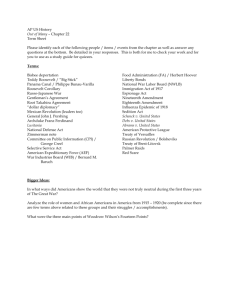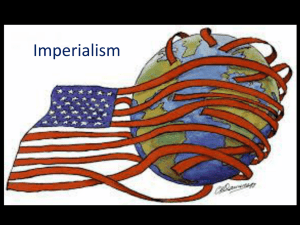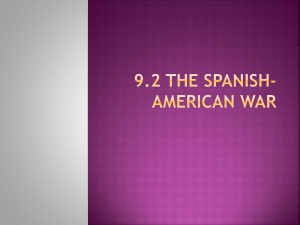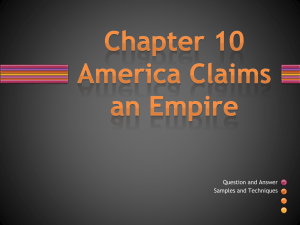America Claims An Empire
advertisement
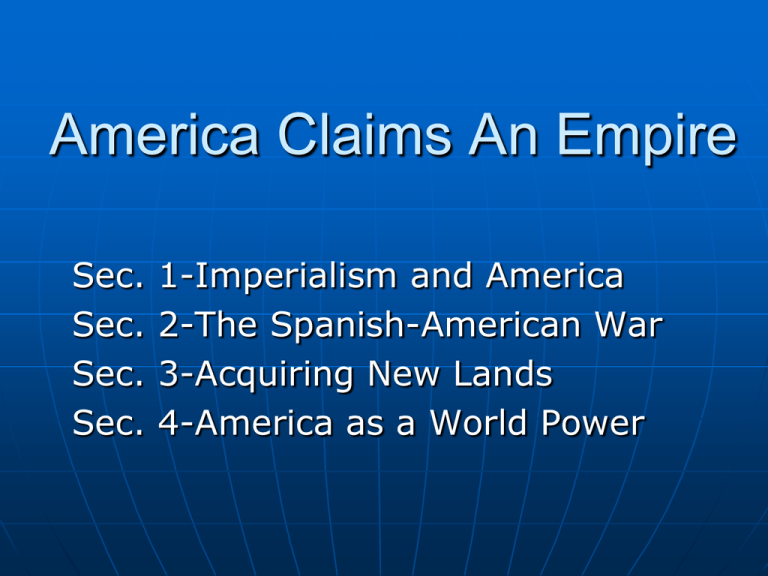
America Claims An Empire Sec. Sec. Sec. Sec. 1-Imperialism and America 2-The Spanish-American War 3-Acquiring New Lands 4-America as a World Power Imperialism and America Section 1 Imperialism – policy in which stronger nations extend their economic, political, or military control over weaker territories Motives • Economic • Military • Religion • Racial Superiority Monroe Doctrine-1823 The Western Hemisphere was closed to any further European colonization. The U.S. would not interfere with any European colonies already established. Any attempt by an European power to intervene in Western Hemisphere affairs would be interpreted as a threat to the U.S. The U.S. would not interfere in the internal affairs of an European country. What is the Message? Global Competition European countries had been establishing colonies since the 1400’s all around the world. Late 1900’s through the turn of the century they focus on competitions for Asian and African nations. World Colonialization 1900 U.S. Motivation for Imperialism Manifest Destiny- Idea that it is the fate of the U.S. to expand its boundaries from the East to West Coast. (By 1890 we had done that) New Manifest Destiny- Idea that it is the fate of the U.S. to expand it boundaries beyond the seas American Progress by John Gast 3 Factors that Fuel U.S. Imperialism Desire for Military Strength • Adm. Alfred Mahan • Influence of Sea Power Upon History: 1660-1783 Build up Navy Need Colonies (Hawaii, Caribbean Is., Canal) Need for refueling stations and raw materials Foreign Trade Thirst for New Markets (Economic) • Too many workers, not enough work • Need places to sell our products Belief in Cultural Superiority • Social Darwinism • Theory of Eugenics • White Man’s Burden White Man’s Burden The U.S. Acquires Alaska William Seward – Sec. of State Acquires Alaska in 1867 Purchased from Russia for $7.2 Million Known as “Seward’s Folly” or “Seward’s Icebox” Turned out to be an excellent investment. • • • • • Oil Fish Timber Minerals like gold Naval Bases 1959 –Alaska becomes a state. The U.S. Takes Hawaii History of Hawaii and the U.S. Cries for Annexation Value of Pearl Harbor The End of a Monarchy • King Kalakaua amends constitution to satisfy white sugar growers – limits voting rights to wealthy landowners • Queen Liliuokalani takes over and wants to restore Hawaii for Hawaiians. Landowners plot to remove her. • Growers plans a revolt and with the help of U.S. Marines remove Queen and place her under house arrest. Sanford Dole is Named President of Hawaii Annexation of Hawaii President Cleveland directs the Queen to be restored but Dole refuses. Recognized the Republic of Hawaii but will not annex unless the majority votes to do so. William McKinley supported annexation and Congress proclaims it an American territory in 1898 with Hawaiians never voting to do so. Hawaii becomes a state in 1959. The Spanish-American War Section 2 1868- Cubans rebel against Spanish rule and fought for 10 years but are defeated. Did abolish slavery. Prosperity in Cuba due to sugar trade with U.S. and McKinley Tariff Act (1890)removes tariff on Cuban sugar Wilson-Gorman Tariff (1894) puts tariff on Cuban sugar and causes economic hard times, leading to a new revolt 2nd War for Independence José Martí – Launched the revolt in 1895 • See Key Player Box pg. 347 Tactics used • Guerrilla Warfare • Scorched Earth Policy Scorched Earth Policy Cuban Rebels burn U.S. owned plantations in an attempt to receive American intervention U.S. does not respond until Spanish start using harsh tactics against the rebels General Weyler, a.k.a. “The Butcher” • Reconcentrado / Concentration Camps General Valeriano Weyler Reconcentrado Camps Conditions Estimated 300,000 Cubans Interned Unsanitary Conditions Thousands died of hunger and disease. http://chss.montclair.edu/wi tness/Reconcentrados.html Causes of the Spanish American War Harsh Tactics against the Cubans Yellow Journalism De Lôme Letter U.S.S. Maine Explodes Yellow Journalism Sensational style of writing, which exaggerates the news to lure and enrage readers • Poisoned Wells • Children throw to sharks Publishers of Yellow Journalism • William Randolph Hearst- New York Journal “You furnish the pictures and I’ll furnish the War.” • Joseph Pulitzer- New York World The De Lôme Letter Written by the Spanish Minister to the U.S. (De Lôme ) Criticized Pres. McKinley • Called him “weak” and “a bidder for the admiration of the crowd” Major Insult that upset the American public. U.S.S. Maine Explodes Who: 260 (plus) U.S.S. Maine crew killed What: Explodes and Sinks Where: Havana Harbor, Cuba When: February 15, 1898 Why: Newspapers blame the Spanish Public Reaction Outrage against Spain Hearst and Pulitzer fan the flames and call for war • Offers $50,000 Reward “Remember the Maine” Battle Cry of Spanish American War Captain Sigsbee • http://www.classzone.com What Really Happened 1976 Investigation concluded a massive internal blast had destroyed the ship. Most likely cause was a spontaneous fire in a coal bunker that ignited a nearby supply of weapons. Faulty design War with Spain Although the Spanish gave in to all demands the U.S. declared war April 20,1898. Philippines Theater of War • 1st battle took place in Manila Bay • Commodore Dewey sailed into the bay and destroyed all the Spanish ships. • U.S. forces landed and joined with Filipino revolutionaries lead by Emilio Aguinaldo • Spain surrenders War in the Caribbean Naval Blockade of Cuba • Victory in Philippines and success of blockade show the superiority of the U.S. Navy. U.S. Army is only a small professional force, with inexperienced volunteers • • • • • Lack of training Lack of weapons Lack of supplies Wool Uniforms for a tropical climate Lack of experienced leadership and old Civil War leaders were more interested in sitting around and talking about the old days. Rough Riders A volunteer cavalry unit commanded by Leonard Wood and Theodore Roosevelt • Made up of men from all walks of life • Dramatic uphill charge at Kettle Hill led by the Rough Riders led to the more significant taking of San Juan Hill Myths about the Rough Riders Myth: They charged up the battlefield on horses as depicted in newspapers and pictures painted about the event. Reality: Horses had been left in Florida. They were dismounted Cavalry. (From the Painting by Frederic Remington.) http://www.bartleby.com/51/10.html Myths about the Rough Riders Myth: Roosevelt lead the main charge up San Juan Hill. Reality: He had led the charge up Kettle Hill and the Rough Riders had assisted in taking San Juan Hill. http://www.eyewitnesstohistory.com /roughriders.htm Roosevelt and the Rough Riders atop San Juan Heights, 1898 http://en.wikipedia.org/wiki/Battle_of_San_Juan_Hill Roosevelt Posthumously Awarded Medal of Honor Though two Medal of Honor recipients who had witnessed Roosevelt's actions at Kettle and San Juan Hills (Generals Shafter and Wood) recommended the intrepid leader of the Rough Riders, his political enemies succeeded in denying it to him during his lifetime. Beyond Roosevelt's death, his actions were http://www.homeofheroes.c debated for decades and finally, more than 100 years after his famous charge om/wallofhonor/spanish_am during the Spanish-American War, /11_crowdedhour.html Congress approved the award. On January 16, 2001 President William Clinton presented Theodore Roosevelt's Medal of Honor to his great-grandson Tweed Roosevelt, in ceremonies at the White House. His award brought the total of awards earned in the July 1, 1898 battles at El Caney, Kettle Hill and San Juan Hill to an even twodozen. Ironically, Roosevelt's longsought Medal of Honor would be the ONLY posthumous award of the entire Spanish-American War. Spanish American War Ends War lasted only 16 Weeks Called a “Splendid Little War” 300,000 Americans served 5,400 lost their lives 379 battle causalities 5,000 died of diseases and other causes • Yellow fever • Malaria Treaty of Paris Spain surrendered all rights to Cuba and assumed Cuban Debt Puerto Rico and Guam are given to U.S. The U.S. will pay $20 million for the annexation of the Philippines Debate over the Treaty Imperialism vs. Democracy McKinley tried to imply it was for the betterment of the Filipino people • “that there was nothing left for us to do but take them all and to educate the Filipinos, and uplift and Christianize them.” What is faulty about that argument? Anti-imperialist would argue “you don’t have to own people to trade with them” Acquiring New Land Section 3 Ruling Puerto Rico Cuba and the U.S. Filipinos Rebel Foreign Influence in China Impact of Imperialism Ruling Puerto Rico Fairly smooth transition Military Rule established U.S. wished to maintain island as a territory for a naval base. Foraker Act – 1900 • Ends military rule • Set up civil government • Pres. Power to appoint governor and upper house to legislature • Denied U.S. citizenship 1917 Granted Citizenship and Right to elect both houses of legislature Puerto Rico Commonwealth of U.S. Make their own laws Handle their own finances U.S. controls defense and set tariffs Citizens of U.S. Move freely between island and mainland Enjoy tax exempt status Do not vote for President Do not have voting members in Congress Do not receive federal aid Subject to military draft Puerto Rico Debate Some want to be independent Some want to be a state Some want to maintain commonwealth status Voted in 1967, 1993, and 1998 What are the pro’s and con’s of each? Guam Smooth Transition U.S. Territory Naval & Air Force Bases U.S. Citizens Guam is the largest and southernmost of the Mariana Islands. Cuba and the U.S. Teller Amendment: The U.S. will not seek control of Cuba. Cuba is officially independent but will become an United States Protectorate • A country whose affairs are partially controlled by a stronger power. U.S. military would occupy Cuba Provide food, clothing, schools, hospitals, and help with malaria and yellow fever. Platt Amendment Condition of U.S. withdrawal • Cubans must have Constitution and sign the Platt Amendment Cuba could not make treaties that might limit its independence or permit foreign powers to control any part of its territory The U.S. reserved the right to intervene in Cuba Cuba was not to go into debt that its government could not repay The U.S. could buy or lease land on the island for naval stations and refueling stations Protecting American Business Interests Main reason for staying involved in Cuba and other places around the world was to protect American businesses with investments in Cuba and other countries. Critics argue it is not necessary. • See Page 355 Personal Voice Filipinos Rebel Emilio Aguinaldo- Leader of Rebellion U.S. is faced with the same situation as Spain in Cuba of a people fighting for independence from a colonial power Aguinaldo uses guerilla warfare U.S. Forces citizens to designated zones like the reconcentrado camps in Cuba • Poor sanitation, starvation, disease • Thousands die African Americans in the Philippines Many of the 70,000 U.S. troops in the Philippines were African American Some deserted to the Filipino side in solidarity for racial prejudice Thomasites 540 young Americans who sailed to Manila aboard the U.S.S. Thomas • Trained Filipino teachers • Conducted classes • Set up schools Impact • 1898 – 5,000 elementary students • 1920 – more than 1 million students Cost of the War Philippine – American War lasted 3 years Human Cost • 20,000 Filipino rebels died • 4,000 U.S. troops died Monetary Cost • $400 million – 20 times the price we paid for annexation Aftermath U.S. set up a similar government to Puerto Rico President appointed a governor • William Howard Taft 1901-1904 Build schools and hospitals Improved Sanitation for the prevention of disease. Independence granted July 4th, 1946 China and the Open Door Policy Because of the Sino-Japanese War China was weakened and vulnerable to imperialistic countries like Britain, Germany, France, Russia, and Japan. Each country had carved out a sphere-of-influence- an area where that country has exclusive rights to control trade and industry. This interfered with U.S. business interests. John Hay’s Open Door Notes Sec. of State Hay issued a series of statements to protect American interests in China. Sent to Britain, France, Russia, Italy, Germany, and Japan. Statements are known as the Open Door Notes. Open Door Policy Called for open access to China’s coastal ports and trading rights of all nations would be respected Elimination of special privileges for any trading nation Existing tariffs would be collected by Chinese officials Railroad rates and harbor duties would not discriminate against people of other countries China would maintain its independence Boxer Rebellion 1900 Chinese patriots called Boxers rebelled, which threatened the Open Door Policy Boxers wanted to rid their country of “foreign devils” Boxers killed 200 missionaries, other foreigners, and converted Christian Chinese and also took over the embassies. 2nd Open Door Note Hay responded by sending the 2nd Open Door Note to propose the great powers unit to put down the rebellion and reinforced the idea of an Open Door in China after the rebellion The International Force, including 2,500 American soldiers, squashed the rebellion. Boxer Protocol Treaty signed by the great powers and China after the Boxer Rebellion Powers agreed to accept money ($332 million) rather than land from China. • U.S. part was $24.5 million. • In 1908 the U.S. returned about $20 million to China for the education of Chinese students • Why do this????????? Chinese agreed to execute some Chinese officials and punish others. Three Deeply Held Beliefs About U.S. Industrial Capitalist Economy Americans believe that the growth of the U.S. economy depends on exports Americans feel they have a right to intervene abroad to keep foreign markets open Americans fear that the closing of an area to American products, citizens, or ideas threatens U.S. survival America as a World Power Section 4 Teddy Roosevelt’s Big Stick Policy William Howard Taft’s Dollar Diplomacy Woodrow Wilson’s Missionary Diplomacy Teddy Roosevelt’s Foreign Policy Roosevelt the Peace Maker • Russo-Japanese War Russia and Japan were competing for Korea and Manchuria Japan wins and Roosevelt steps in to offer to negotiate the peace agreement Treaty of Portsmouth • • • • Southern ½ of Sakhalin Island Japan gave up the cash payment Japan took over Russian interests in Manchuria and Korea Both countries agreed to the Open Door in China Aftermath of Treaty of Portsmouth • Japan upset about not receiving the money • Roosevelt wins the Nobel Peace Prize • Gentleman’s Agreement over segregated schools in California The Great White Fleet Roosevelt sends 16 battleships (10 brand new) on a world cruise to show the power of the U.S. and its Navy. Fleet puts into ports around the world, including Japan U.S. and Japan will pledge to respect each other’s possessions and interests in East Asia and the Pacific in various treaties. Roosevelt and the Panama Canal Why do we need the Panama Canal? • Eliminate the trip around South America • Lower cost for shipping • Lower cost for maintenance of separate fleets • Improved defense of the Western Hemisphere http://www.hippocampus.org/US%20History%20II Possible Locations Nicaragua • Problem: Volcanoes Mexico • Problem: Distance Panama • Problem: Rights owned by France Hay-Herrán Treaty Treaty between U.S. and Columbia • 6 mile zone • 99 year lease with renewal privileges • U.S. pays 10 million in cash • Plus $250,000 a year starting in 1912 Columbia rejects treaty Panamanian Revolt Instigated by French Company official- Philippe Bunau-Varilla and wealth U.S. business interests U.S. (Teddy Roosevelt) sent the U.S.S. Nashville and other ships off the coast of Panama and Columbia to keep Columbia from interfering Hay / Bunau-Varilla Treaty Treaty between U.S. and Panama • 10 mile zone • U.S. pays 10 million • Plus $250,000 a year to begin in 1913 Ratified in 1904 Building the Canal Digging began in 1904 but stopped a year later due to the high death rates in the Canal Zone Same problems the French had • Malaria • Yellow Fever • Plague Cleaning up the Canal Zone Colonel William Gorgas in charge of sanitation program • Drained Swamps • Installed Sewers • Screened Buildings • Paved Roads Building Resumes in 1907 Greatest Engineering Feat of the Time 5 or 6 Lock System for raising and lowering ships through the canal. Total Cost – $380,000,000 Employed thousands of workers • 5,600 died from accident and disease Opened in 1914 Damaged U.S. – Latin American Relations Roosevelt Corollary Roosevelt argued European powers must not intervene in the Western Hemisphere as put forth in the Monroe Doctrine, but also warned that disorder in Latin America might “force the U.S. to exercise an international police power” in order to protect U.S. economic interests. http://www.hippocampus.org/US%20History%20II Dollar Diplomacy under Taft Dollars for Bullets Policy of using the U.S. Government to guarantee loans made to foreign countries by American businesspeople Used to keep European powers from intervening in Latin America http://www.hippocampus.org/US%20History%20II Taft and the Monroe Doctrine Japan attempted to purchase Baja California from Mexico Why is that not good for the U.S.??? U.S. expresses its concern to Japan and they back off. Lodge Corollary • Any attempt to sell strategic land located in the Americas to a nation or company outside the Western Hemisphere would be opposed by the U.S. Missionary Diplomacy and Wilson Purpose is to help other nations Cooling Off Treaties – international disputes were to be referred to a commission that would investigate and make a report. The parties of the dispute must refrain from war in the year it took to compile the report Wilson and Mexico U.S. has a moral responsibility to deny recognition to any Latin American government it viewed as oppressive, undemocratic, or hostile to U.S. interests. This policy on non-recognition will be tested in Mexico. http://www.hippocampus.org/US%20History%20II Important People President Diaz –1876 to 1911 was Mexico’s military dictator Francisco Madero – Leader of rebellion and new President in 1911 General Huerta – Killed Madero and took over the government in 1913 Venustiano Carranza – Leader of Constitutionalists fighting Huerta Francisco “Pancho” Villa – Leader of revolt against first Huerta and then Carranza. Attacks U.S. Dolphin Incident American whale boat puts into Tampico Crew arrested by Huerta’s men Released with apology Admiral Mayo demands a 21 gun salute Huerta insulted and demands on in return Incident leads to the invasion of Vera Cruz by the U.S. Navy resulting in 19 U.S. deaths and around 200 Mexican. U.S. close to war with Mexico ABC Powers Step In Argentina, Brazil and Chile offer to negotiate a settlement to the conflict and a grateful Wilson accepts In the meantime Huerta is overthrown by Carranza Villa breaks with Carranza Pancho Villa on a Rampage Angry at U.S. for Wilson’s recognition of Carranza’s Government Kills 16 American Engineers in Mexico Crosses U.S. border and conducts a raid on Columbus, New Mexico, killing 17 Americans Wilson Sends Troops General John J. Pershing – led 15,000 troops deep into Mexico to catch Pancho Villa. Caused much stress between the U.S. and Mexico, almost to the point of war. Pancho Villa never captured. U.S. Troops Withdraw Wilson is up for reelection and so does not withdraw troops until January of 1917. Problems in Europe are worsening and Wilson sees we will soon be in another war.


